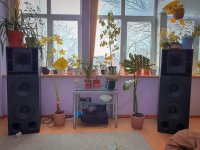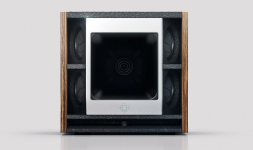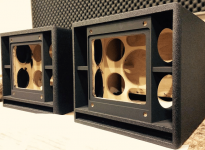milezone,
Thank you for posting your subjective impressions of these drivers. It's an impressive collection of drivers and an interesting approach to compare them in a raw out of the box fashion. I find it's helpful information because, for reasons that I cannot necessarily justify, I prefer compression drivers that sound good with no EQ applied in a two-way system.
Thank you for posting your subjective impressions of these drivers. It's an impressive collection of drivers and an interesting approach to compare them in a raw out of the box fashion. I find it's helpful information because, for reasons that I cannot necessarily justify, I prefer compression drivers that sound good with no EQ applied in a two-way system.
Well that's not typical at all ! What exactly are you talking about, no passive eq on the compression driver? Which driver and horn combo do you find best (no eq 2 way?) ThanksI prefer compression drivers that sound good with no EQ applied in a two-way system.
Yes, call me crazy for sub-optimal audio enjoyment. My three favorite CDs are; TAD 2001 - so smooth, detailed, and extended highs. GPA 802-8G - lovely warm upper mid-range sound and I don't mind that they are rolled off high. And the Faital Pro HF108R - which just simply sounds very good to me with no EQ.
For horns, I mix and match between a Joseph Crowe ES800, Fostex H420 wide dispersion radial made from solid teak, and the Altec 32C bent horns. I cross over from a 12 inch woofer at about 1500 Hz with a second order passive filter.
I have no measurements and I don't doubt that any or all of these combos could benefit from some crossover optimization. But, I'm happy with what I have.
For horns, I mix and match between a Joseph Crowe ES800, Fostex H420 wide dispersion radial made from solid teak, and the Altec 32C bent horns. I cross over from a 12 inch woofer at about 1500 Hz with a second order passive filter.
I have no measurements and I don't doubt that any or all of these combos could benefit from some crossover optimization. But, I'm happy with what I have.
Looks like Beyma TPL150H
https://www.beyma.com/speakers/Fichas_Tecnicas/beyma-speakers-data-sheet-amt-TPL150H.pdf
https://www.beyma.com/speakers/Fichas_Tecnicas/beyma-speakers-data-sheet-amt-TPL150H.pdf
Great point Brett...On the topic of compression drivers and AMTs this article explains why AMTs have some benefits over compression drivers and specifically as related to distortion:
https://www.mundorf.com/userdata/filegallery/original/52_en_proamt_rah_jt_cinema_en_print_final.pdf.
I've sold several of the drivers which I tested and of those the TPL200 is the one I regret selling most. I may revisit that driver or a Mundorf (people seem to prefer the Beyma AMTs), though I think, of a similar nature, a compact electrostatic panel that can produce and handle relatively high spl would be a step up sonically and more interesting to explore.
https://www.mundorf.com/userdata/filegallery/original/52_en_proamt_rah_jt_cinema_en_print_final.pdf.
I've sold several of the drivers which I tested and of those the TPL200 is the one I regret selling most. I may revisit that driver or a Mundorf (people seem to prefer the Beyma AMTs), though I think, of a similar nature, a compact electrostatic panel that can produce and handle relatively high spl would be a step up sonically and more interesting to explore.
Last edited:
And the winner is...
Just thought I would throw it into the discussion for comparison for those who might not know these spectacularly good drivers.
(No offence or dishonesty intended Brett...).
For sure, if flat as pancake highs (beaming vertical) is not a problem why not, seems good. Compression drivers aren't exactly needed at home. Compression is mainly to increase sensitivity, if I've understood correctly, to reach crazy loud SPL levels without bad sounding distortion, which really isn't needed at home use and the extra sensitivity usually demands a pad. One could put a dome into a waveguide as well. Or a planar driver but as the radiating surface enlarges sensitivity goes up but the highs beam. Classic pick your poison situation 🙂 Allowing one self to use EQ to fix things which it is perfectly capable of fixing vastly increases options.
For good compression driver, look the HF decay. I believe this is related mostly with phase plug and other internal parts of the driver, some resonance somewhere. If there is not this kind of long decay for highs, or with any parts of the response, expect good sound I think. The rest is just matter of straightening up with EQ and use good waveguide to get polar response good. Do not use bad waveguide / horn that makes reflections and diffraction because they would be there no matter what drives it.
I've seen burst decay / CSD / wavelet plots on the forums many times, just can't find them currently to make a proper illustration 😀 Most drivers have these and mr. Gunness has his Temporal EQ thing fixing some of this as well, I believe. Anyway, here is my HF10AK in RCF H100 graphs illustrating it. Both are same measurement just different scale. The black and white image is to be comparable to some burst decay plots I found here https://josephcrowe.com/blogs/news/es-2000-biradial-with-various-compression-drivers
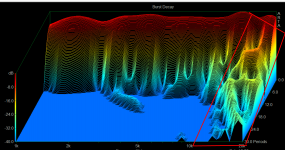
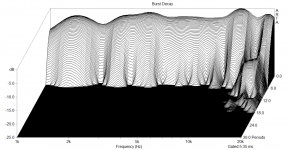
edit. found measurement of HF10AK in STH100 waveguide as well. As one sees the top octave, wavelengths ~< throat diameter, are defined by the driver and not the waveguide, at least in this case 🙂
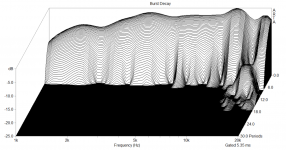
edit. Found some impedance measurement, I believe with STH100. Something resonates at the top. I'm curious which drivers don't have these. milezone, any chance you have measurements int ARTA / REW that could show the decau of the drivers you have?
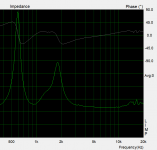
edit:
Gunness paper https://www.fulcrum-acoustic.com/wp...dspeaker-transient-response-with-dsp-2005.pdf
I've seen burst decay / CSD / wavelet plots on the forums many times, just can't find them currently to make a proper illustration 😀 Most drivers have these and mr. Gunness has his Temporal EQ thing fixing some of this as well, I believe. Anyway, here is my HF10AK in RCF H100 graphs illustrating it. Both are same measurement just different scale. The black and white image is to be comparable to some burst decay plots I found here https://josephcrowe.com/blogs/news/es-2000-biradial-with-various-compression-drivers


edit. found measurement of HF10AK in STH100 waveguide as well. As one sees the top octave, wavelengths ~< throat diameter, are defined by the driver and not the waveguide, at least in this case 🙂

edit. Found some impedance measurement, I believe with STH100. Something resonates at the top. I'm curious which drivers don't have these. milezone, any chance you have measurements int ARTA / REW that could show the decau of the drivers you have?

edit:
Gunness paper https://www.fulcrum-acoustic.com/wp...dspeaker-transient-response-with-dsp-2005.pdf
Last edited:
Edit time over, here is the associated patent by mr Gunness https://patents.google.com/patent/US8081766B2/en
I plan to start making measurements eventually. I'm waiting on some active analog crossovers which I plan to test before exploring active digital. Having sorted out which compression drivers I like for the most part my next step is to test some 15" woofers and 5-8" mid drivers. I have a few speaker designs in mind which I would like to test and compare with what I already have -- primarily a coaxial similar to a synergy horn without the multiple entry component -- see photos below. And also a mid dome, tweeter design somewhat akin to the upper section of a Linkwitz LX521. I'm optimizing things to be as modular as possible so I can easily swap components and sections upon finding something that I prefer. While not highly scientific I find the observations in Lamizator's speaker building explorations insightful: http://lampizator.eu/SPEAKERS/Loudspeakers.html. I anticipate that as my explorations progress I'll feel more of an urge to start making measurements.
Attachments
Absolutely... appreciate Lampizator's reliance on intuition -- ya know like when you see a beautiful girl whom you find attractive and are drawn to for ultimately inexplicable reasons... I respect the opinions of people who accept that as part of reality and are guided by intuition. I disrespect the failure to accept the importance of perception -- scientifically speaking neurologically. Things can be examined from a basic perspective using simple analytical tools, or in an infinitely complex and holistic way. Given the complexity of every analyzable scenario, using the tool of the mind and in this case the ears, can yield just as informative or desirable outcomes as scientific analysis would. And in some instances I find that that scientific analysis can cloud our observation of that which is obvious, pursuing that which we perceptually enjoy and rejecting that which we don't. I think this is important to observe when designing things. The AXI2050 for example feels whimsical to me in that it's an ultimately unimpressive and unevolved product relative to what one could do with that amount of scientific and engineering knowledge. I attribute some of this outcome to an over reliance on scientific thinking at the cost of ingenuity. I'm on the side of science though -- as I don't side with the fairy tales, rainbows, boy scouts and the Hanson Brothers as a way of life... sue me.Not even close.
Last edited:
Has anyone tried the Beyma CD11ND?
Milezone, I read your very unscientific results 😉 with interest and while I get your philosophy, I don't fully understand your overall strategy. For example what is the point of testing an axi 2050 if you're going to cut it at 1.2kHz? Seems to me most 1" drivers would work at that cutoff. I don't get testing w/o horn loading either.
Milezone, I read your very unscientific results 😉 with interest and while I get your philosophy, I don't fully understand your overall strategy. For example what is the point of testing an axi 2050 if you're going to cut it at 1.2kHz? Seems to me most 1" drivers would work at that cutoff. I don't get testing w/o horn loading either.
Do you have a vertical spectrogram (or equivalent) for the K402?I've listened to a few 2" compression drivers, and have owned TAD TD-4002s for over 12 years--on my K-402 horns. They are the standard by which I judge other drivers.
More recently (last March), I evaluated a Celestion Axi2050 on a K-402 horn in a stereo arrangement with the other K-402 mounting a TAD TD-4002. Since the transfer function of the two drivers/horns in-room were essentially the same, I was able to listen to them in as a stereo pair. My comments are found here:
https://community.klipsch.com/index...on-driver-on-k-402-horn-and-jubilee-bass-bin/
I also run a BMS 4592ND (bi-amped) in my center K-402-MEH--a full-range loudspeaker based in a three-way (including the 4592's two diaphragms) multiple entry horn using dual 15" woofers-- discussed more here: https://community.klipsch.com/index.php?/topic/161404-a-k-402-based-full-range-multiple-entry-horn/.
All in all, I don't believe that your focus on harmonic distortion (HD) is a good way to evaluate these drivers--at all. In my experience, the factors that are audible that differentiate the drivers are:
1) smooth non-breakup SPL and phase performance above 6-7 kHz (very audible)
2) timbre of the driver vis-à-vis TAD TD-4002s (almost as audible, but requiring significantly more time to evaluate using a variety of recordings)
3) "sparkle" or lightness to the presentation that correlates with the diaphragm's ability to play without breakup with ease above 10 kHz (least audible and requiring many hours of listening to form an impression--greater than 20 hours.
Under this scale, my impressions are the following (fully dialed-in drivers/K-402 horns using First Watt F3):
1) TAD TD-4002: no coloration, no audible diaphragm breakup even at high SPL, and plenty of naturalness and sparkle.
2) Celestion Axi2050: no coloration, no audible breakup on cymbals, etc., but slightly lower sparkle and naturalness, almost not audible even after many listening hours.
3) BMS 4592ND (bi-amped, time aligned): no coloration, no audible breakup on cymbals, etc., but slightly more irregular SPL response around the internal two diaphragm crossover point (~6 kHz). No real audible differences between the TD-4002s and the 4592NDs.
All three have almost no differences in listening quality, especially after using a "phase plug extension" (or otherwise described as a horn throat diverging acoustic lens) that spreads out the polars of the 2" diameter throat, which doesn't affect on-axis SPL response, but significant increases the large off-axis timbre consistency. I would seriously doubt anyone could tell the difference under blind test conditions. I haven't heard any other drivers (including AMTs, etc.) that could match the presentation of these three drivers on a K-402 horn, fully dialed-in.
I can answer more questions about the differences, above and the other drivers/horns that I've evaluated, but this is a good place stop for now.
Chris
I'm trying to find an appropriate in wall horn/driver for a 700mm wide space (k402 on its side)
Chris, very interesting link you posted. Just two things. In my recollection, the hair cells in the inner ear have very steep, but unequal response curves on either side of the slope. They must be much more selective than the 1/3 rd octave claimed in the link. Also the number of inner hair cells, some 3500, points to much higher selectivity. More like 350 bands per octave.In my direct experience, 230-300 Hz with an Axi2050 on a K-402 horn works well.
Using other 2" drivers, I recommend something around 500 ±100 Hz. I don't recommend crossing higher than 900 Hz-1 kHz--for some pretty important psychoacoustic reasons (starting on slide 17)--if clarity of presentation is important to you. Getting the throat apertures within 1/4 wavelength at the crossover frequency is pretty important for performance reasons, in my experience.
Perhaps you should consider stating your loudspeaker design requirements--rather than inserting apparent design solutions...which perhaps much less clearly imply the requirements assumptions that you're making.
Chris
A second point is that I don't quite get why this should be relevant to crossover point, as long as both loudspeakers produce identical phase shifts.
Paul
- Home
- Loudspeakers
- Multi-Way
- Best Compression Drivers today 2022?
